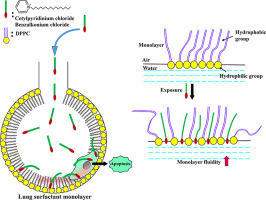当前位置:
X-MOL 学术
›
Chem. Biol. Interact.
›
论文详情
Our official English website, www.x-mol.net, welcomes your
feedback! (Note: you will need to create a separate account there.)
Benzalkonium chloride and cetylpyridinium chloride induce apoptosis in human lung epithelial cells and alter surface activity of pulmonary surfactant monolayers.
Chemico-Biological Interactions ( IF 4.7 ) Pub Date : 2020-01-24 , DOI: 10.1016/j.cbi.2020.108962 Sanae Kanno 1 , Seishiro Hirano 2 , Hideaki Kato 1 , Mamiko Fukuta 1 , Toshiji Mukai 3 , Yasuhiro Aoki 1
Chemico-Biological Interactions ( IF 4.7 ) Pub Date : 2020-01-24 , DOI: 10.1016/j.cbi.2020.108962 Sanae Kanno 1 , Seishiro Hirano 2 , Hideaki Kato 1 , Mamiko Fukuta 1 , Toshiji Mukai 3 , Yasuhiro Aoki 1
Affiliation

|
Quaternary ammonium compounds (e.g., benzalkonium chloride (BAC) and cetylpyridinium chloride (CPC)) constitute a group of cationic surfactants are widely used for personal hygiene and medical care despite the potential pulmonary toxicity. To examine whether BAC and CPC aerosols deposited in the alveolar region alter pulmonary function, we studied the effects on pulmonary surfactant using two-step in vitro models; cytotoxicity using A549 alveolar epithelial cell and changes in surface activity of the pulmonary surfactant monolayer using both Surfacten® and 1,2-dipalmitoyl-sn-glycero-3-phosphocholine (DPPC). Cell viability was decreased with BAC and CPC dose-dependently. A comparison of cytotoxicity among BAC homologues with different length of alkyl chain showed that C16-BAC, which has the longest alkyl chain, was more cytotoxic than C12- or C14-BAC. Caspase-3/7 activity and cleaved form of caspase-3 and PARP were increased in BAC- and CPC-exposed cells. The elevated caspase-3/7 activity and their cleaved active forms were abolished by caspase-3-inhibitor. Furthermore, we examined the features of the surface pressure/trough area (π-A) isotherm by the Langmuir-Wilhelmy method and atomic force microscopy (AFM) images of lipid monolayers on a subphase containing BAC, CPC, or pyridinium chloride (PC, as a control). The π-A isotherms showed that addition of BAC or CPC yielded dose-dependent increases in surface pressure without compression, indicating that BAC and CPC expand the isotherm to larger areas at lower pressure. The collapse pressure diminished with increasing concentration of CPC. Topographic images indicated that BAC and CPC resulted in smaller condensed lipid domains compared to the control. Conversely, PC without hydrocarbon tail group, showed no cytotoxicity and did not change the isotherms and AFM images. These results indicate that BAC and CPC cause cell death via caspase-3-dependent apoptotic pathway in A549 cells and alter the alveolar surfactant activity. These effects can be attributed to the long alkyl chain of BAC and CPC.
中文翻译:

苯扎氯铵和鲸蜡基吡啶鎓氯化物诱导人肺上皮细胞凋亡,并改变肺表面活性剂单层的表面活性。
季铵化合物(例如,苯扎氯铵(BAC)和十六烷基氯化吡啶(CPC))构成一组阳离子表面活性剂,尽管具有潜在的肺毒性,但它们仍广泛用于个人卫生和医疗保健。为了检查沉积在肺泡区域的BAC和CPC气溶胶是否会改变肺功能,我们使用两步体外模型研究了对肺表面活性剂的影响。使用A549肺泡上皮细胞产生细胞毒性,同时使用Surfacten®和1,2-二棕榈酰-sn-甘油3-磷酸胆碱(DPPC)改变肺表面活性剂单层的表面活性。BAC和CPC剂量依赖性地降低了细胞活力。比较不同烷基链长度的BAC同源物的细胞毒性表明,C16-BAC具有最长的烷基链,比C12-或C14-BAC具有更高的细胞毒性。在暴露于BAC和CPC的细胞中,caspase-3 / 7活性以及caspase-3和PARP的裂解形式均增加。caspase-3抑制剂消除了升高的caspase-3 / 7活性及其裂解的活性形式。此外,我们通过Langmuir-Wilhelmy方法检查了表面压力/槽面积(π-A)等温线的特征,并对包含BAC,CPC或氯化吡啶鎓(PC,作为对照)。π-A等温线表明,添加BAC或CPC会在不压缩的情况下在表面压力上产生剂量依赖性的增加,表明BAC和CPC在较低压力下将等温线扩展到更大的区域。崩溃压力随着CPC浓度的增加而减小。地形图表明,与对照相比,BAC和CPC产生的缩合脂质结构域较小。相反,没有烃尾基的PC没有显示出细胞毒性,也没有改变等温线和AFM图像。这些结果表明,BAC和CPC通过A549细胞中的caspase-3依赖性凋亡途径引起细胞死亡,并改变了肺泡表面活性剂的活性。这些影响可以归因于BAC和CPC的长烷基链。
更新日期:2020-01-24
中文翻译:

苯扎氯铵和鲸蜡基吡啶鎓氯化物诱导人肺上皮细胞凋亡,并改变肺表面活性剂单层的表面活性。
季铵化合物(例如,苯扎氯铵(BAC)和十六烷基氯化吡啶(CPC))构成一组阳离子表面活性剂,尽管具有潜在的肺毒性,但它们仍广泛用于个人卫生和医疗保健。为了检查沉积在肺泡区域的BAC和CPC气溶胶是否会改变肺功能,我们使用两步体外模型研究了对肺表面活性剂的影响。使用A549肺泡上皮细胞产生细胞毒性,同时使用Surfacten®和1,2-二棕榈酰-sn-甘油3-磷酸胆碱(DPPC)改变肺表面活性剂单层的表面活性。BAC和CPC剂量依赖性地降低了细胞活力。比较不同烷基链长度的BAC同源物的细胞毒性表明,C16-BAC具有最长的烷基链,比C12-或C14-BAC具有更高的细胞毒性。在暴露于BAC和CPC的细胞中,caspase-3 / 7活性以及caspase-3和PARP的裂解形式均增加。caspase-3抑制剂消除了升高的caspase-3 / 7活性及其裂解的活性形式。此外,我们通过Langmuir-Wilhelmy方法检查了表面压力/槽面积(π-A)等温线的特征,并对包含BAC,CPC或氯化吡啶鎓(PC,作为对照)。π-A等温线表明,添加BAC或CPC会在不压缩的情况下在表面压力上产生剂量依赖性的增加,表明BAC和CPC在较低压力下将等温线扩展到更大的区域。崩溃压力随着CPC浓度的增加而减小。地形图表明,与对照相比,BAC和CPC产生的缩合脂质结构域较小。相反,没有烃尾基的PC没有显示出细胞毒性,也没有改变等温线和AFM图像。这些结果表明,BAC和CPC通过A549细胞中的caspase-3依赖性凋亡途径引起细胞死亡,并改变了肺泡表面活性剂的活性。这些影响可以归因于BAC和CPC的长烷基链。











































 京公网安备 11010802027423号
京公网安备 11010802027423号